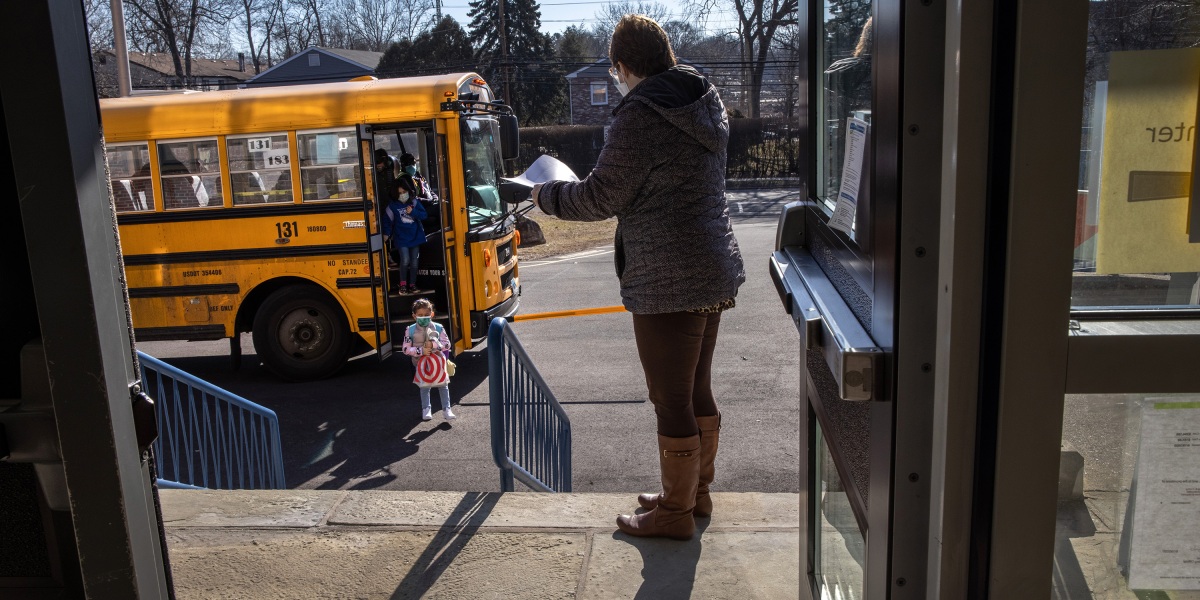
“Cleaning high-touch areas is very important in schools,” Cogan said. But mask-wearing, physical distancing, vaccinations, and other measures are “higher protective factors.”
8. Give agency to parents and teachers in protecting their kids.
Last school year, many districts used temperature checks and symptom screenings as an attempt to catch infected students before they gave the coronavirus to others. But in Austin, Indiana, such formalized screenings proved less useful than teachers’ and parents’ intuition. Instructors could identify when a student wasn’t feeling well and ask them to go see the nurse, even if that student passed a temperature check.
Jetelina said that teachers and parents can both act as a layer of protection, stopping a sick child from entering the classroom. “Parents are pretty good at understanding the symptoms of their kids and the health of their kids,” she said.
In Andrews, Texas, district administrators provided parents with information on covid symptoms and entrusted those parents to determine when a child may need to stay home from school. The Texas district may have “gone way overboard with giving parents agency,” though, Cogan said, in allowing students to opt out of quarantines and mask-wearing—echoing concerns from the Andrews County public health department.
9. We need more granular data to drive school policies.
Throughout the pandemic, I’ve consistently called out a lack of detailed public data on covid-19 cases in schools. The federal government still does not provide such data, and most states offer scattered numbers that don’t provide crucial context for cases (such as in-person enrollment or testing figures). Without these numbers, it is difficult to compare school districts and identify success stories.
My research on school reopenings illuminated another data issue: most states are not providing any covid-19 metrics down to the individual district, making it hard for school leaders to know when they must tighten down on or loosen safety protocols. At the tiny Port Orford–Langlois district in Oregon, for example, administrators had to rely on covid-19 numbers for their overall county. Even though the district had zero cases in fall 2020, it wasn’t able to bring older students back in person until the spring because outbreaks in another part of the county drove up case numbers. Cogan has observed similar issues in New Jersey.
At a local level, school districts may work with their local public health departments to get the data they need for more informed decision-making, Jetelina said. But at a larger, systemic level, getting granular covid-19 data is more difficult—a job for the federal government.
10. Invest in school staff and invite their contributions to safety strategies.
School staff described working long hours, familiarizing themselves with the science of covid-19, and exercising immense determination and creativity to provide their students with a decent school experience. Teaching is typically a challenging job, but in the last 18 months, it has become heroic—even though many people outside school environments take this work for granted, Jetelina said.
Districts can thank their staff by giving them a say in school safety decisions, Cogan recommended. “Educators—they’ve had a God-awful time and had a lot more put on them,” she said. But “every single person that works in a school has as well.” That includes custodians, cafeteria workers, and—crucially—school nurses, who Cogan calls the “chief wellness officers” of the school.
11. Allow students and staff the space to process pandemic hardship.
About 117,000 children in the US have lost one or both parents during the pandemic, according to research from Imperial College London. Thousands more have lost other relatives, mentors, and friends—while millions of children have faced job loss in their families, food and housing insecurity, and other hardships. Even if a school district has all the right safety logistics, school staff cannot truly support students unless they allow time and space to process the trauma that they’ve faced.
P.S. 705 in Brooklyn may serve as a model for this practice. School staff preemptively reached out to families when a student missed class, offering support: “705 is just the kind of place where it is a ‘wrap your arms around the whole family’ kind of a school,” one parent said.
On the first day of school in September 2021—when many students returned in person for the first time since spring 2020—the school held a moment of silence for loved ones that the school community has lost.
New challenges ahead
These lessons are drawn from school communities that were successful in the 2020-2021 school year, before the delta variant hit the US. This highly transmissible strain of the virus poses new challenges for the fall 2021 semester. The data analysis underlying this project led me to profile primarily rural communities, which may have gotten lucky with low covid-19 case numbers in previous phases of the pandemic—but are now unable to escape delta. For example, the Oregon county including Port Orford–Langlois saw its highest case rates yet in August 2021.
The delta challenge is multiplied by increasing polarization over masks, vaccines, and other safety measures. Still, Jetelina pointed out that there are also “a ton of champions out there,” referring to parents, teachers, public health experts, and others who continue to learn from past school reopening experiences—and advocate for their communities to do a better job.
The Solutions Journalism Network supported this project with a reporting grant, as well as trainings and other guidance. Learn more about the five school communities I profiled in this project for the COVID-19 Data Dispatch.
This story is part of the Pandemic Technology Project, supported by The Rockefeller Foundation.






